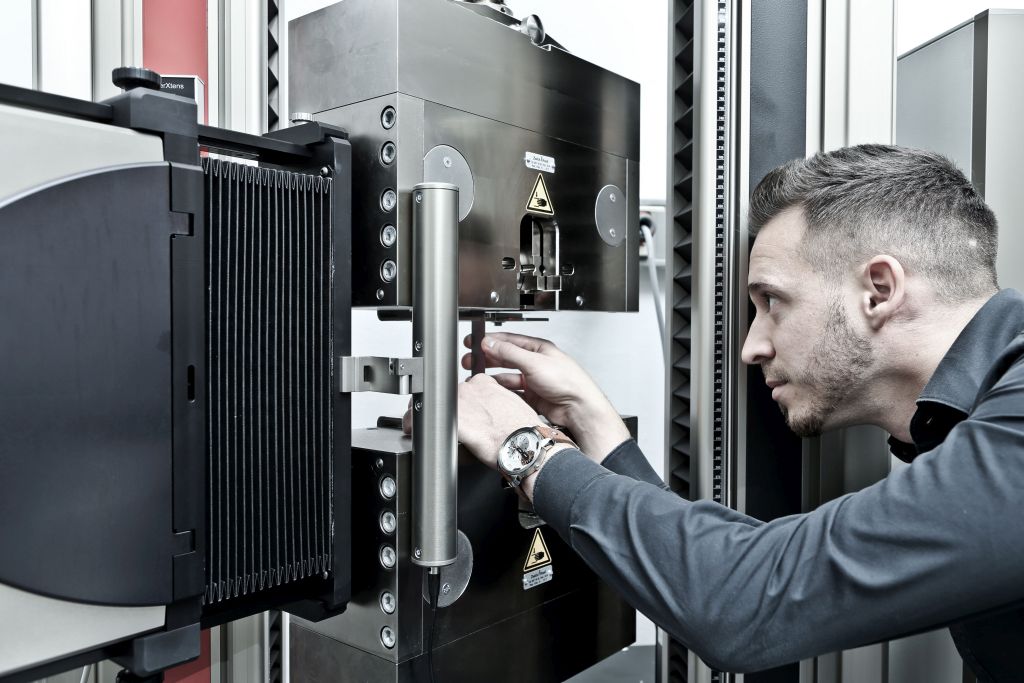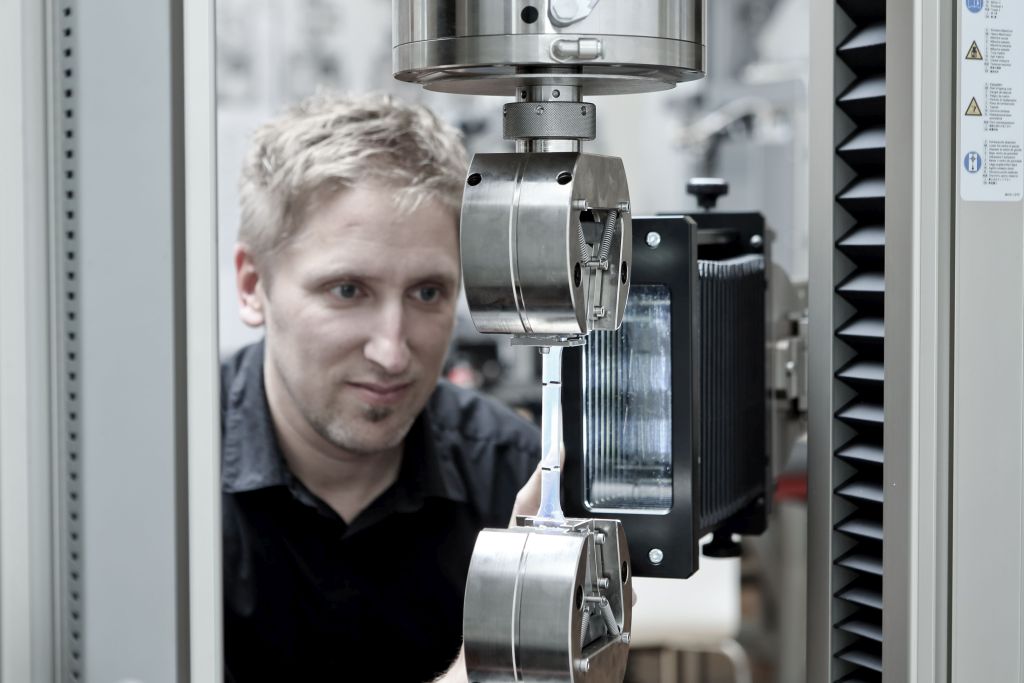Testing times ahead for CMCs

Zwick discusses how reliable high-temperature testing of ceramic matrix composites plays a vital role in the quality assurance of the products for which they are used.
The evolution of ceramic matrix composites (CMCs) promises lightweight and high temperature resistance of materials for maximum product efficiency. Reliable high-temperature testing of these materials plays a pivotal role in the quality assurance of the products for which they are used. Thermodynamics states that the higher the temperature, the greater the efficiency of heat to work conversion.
This relationship, strongly tied to CMCs, a material used in combustion chambers, aircraft and spacecraft engines, pistons, rotors, and more, motivates the ongoing global pursuit of increased material efficiency across industries. Highly durable, lightweight materials that can be safely used at temperatures of 540ºC (1,000ºF) and well beyond in the name of economic gain and sustainability, have become today’s promise.
In CMCs, both the reinforcement and matrix material are ceramic. Because of their high fracture toughness and damage tolerance, CMCs were designed to serve in critical structural parts and components that are subjected to severe environments, including rocket and aircraft engines.
To take it a step further, developers moved on to ultra-high temperature ceramic matrix composites (UHTCMCs), pushing the temperature boundaries of currently used CMCs. When it comes to advanced rocket and aircraft engines, for example, CMCs and UHTCMCs are replacing heavy super alloys, or metal matrix composites, to support rising engine operating temperatures that lead to increased efficiency and lower weight.

High-temperature tests are used to determine the thermomechanical properties of CMCs at extremely high temperatures. These tests play a pivotal role, not only in R&D, but in the quality assurance of critical components used in various sectors. The mechanical load bearing capacity of CMCs is more commonly tested at ultra-high temperatures up to 2,000°C. This involves evaluating the suitability of CMCs for specific applications using tensile, compression, flexure, creep fatigue and shear tests. To ensure that CMCs are tested under real operating conditions, these destructive test methods are carried out in vacuum and inert gas conditions in a temperature range from 650°C up to 2,000°C. As these CMC materials continue to develop, testing equipment and processes must follow suit. This not only applies to the ever-evolving vision and objectives of material developers, but also respective industry standard requirements.
Gaining precise control
Controlling the temperature with maximum precision and minimal user influence is crucial in achieving reliable test results at high temperatures. When materials are tested, the testing system is preset with the required test temperature. This temperature is normally determined by industry standards that account for real-life applications. As mentioned earlier, these may include the high temperatures and temperature fluctuations to which aircraft engines are subjected, for example. Within the realm of technological advancements, material developers are pushing temperature boundaries for aircraft engine components. Higher combustion temperatures lead to higher fuel efficiencies. With current jet engines reaching temperatures as high as 1,700°C, it will be interesting to observe what the new boundaries can become. Because materials are typically sensitive to temperature, any deviation to the set temperature would render incorrect results for characteristic values such as proof strength, ultimate tensile strength, elongation at break, and more.
How is this achieved?
One of the key components for precise temperature measurement in high-temperature testing is the thermocouple. Thermocouples are sensors that measure temperature, and for materials testing purposes, these are directly attached to the specimen. Depending on the size of the specimen, up to three spring-loaded thermocouples encased in a CMC protective tube, are securely attached to ensure accurate temperature readings, and therefore repeatable and reproducible measurements. In addition, uniform temperature distribution is achieved with controllable heating zones within the furnace.

Precision in high-temperature testing assumes that the temperature measurement chain, including a temperature controller and thermocouples (for temperatures up to approximately 1,700°C or pyrometers for temperatures above 1,700°C) is calibrated, and that the testing system controller is set up correctly. Intelligent control algorithms ensure that the specimen temperature is reached and maintained in compliance with the standards without overshooting, and that the temperature remains stable along the specimen with minimal temperature scattering. Automatic controller settings further optimise heating times and minimise user interference.
Strain measurement
Another key consideration in obtaining reliable test results in high-temperature testing of CMCs is the precision of strain measurements regardless of specimen shape and size, and depending on material characteristics, also the precision of strain rate control. Material strain is the deformation of a material when subjected to stress (load application). The stress to strain relationship is normally represented by a stress-strain curve, which helps material developers compare materials and assess how a part made of that material may behave in real-life applications. Strain rate is the change in strain or deformation of that material with respect to time (how quickly or slowly is the material undergoing deformation). And strain rate sensitivity (SRS) tells us that a material’s stress versus strain characteristic depends on the rate of the load application. For example, if a load is applied at two different speeds and there is no change in the specimen strain from one load application scenario to the other, it is safe to say that the material is not strain rate sensitive. However, if the speed of the load application results in two different strain values, the material would most likely be considered strain rate sensitive. Strain rate is important because it has an immense impact on the repeatability of test results. If strain measurements are not precise, they can lead to incorrect measurement values being published in result reports provided by materials testers. These are often the same data reports engineers rely on when designing and developing critical CMC structures for the previously mentioned aircraft or spacecraft engine. The best way to achieve strain rate consistency in materials testing is through closed loop strain rate control. In closed loop testing, the materials testing machine controls the strain rate based on the feedback of an extensometer.
Getting a grip
When testing CMCs at high temperatures, to ensure reliable and repeatable test results, both stability and alignment play a crucial role in specimen gripping.
In materials testing, specimen grips are a key component of the measurement chain. When a specimen is not held securely in the grips, bending strains and slippage can occur, which can lead to incorrect measurements, invalid test results, valuable loss of time and the compromise of operator safety. It is therefore important to ensure secure and properly aligned specimen gripping.
Selecting the proper specimen grips and fixtures according to the type of specimen and test requirements will minimise variability in test results. When it comes to gripping for ultra-high temperature tests, grips are form-fit to the shape of the specimen. Depending on the test standard, the most common specimens can be shoulder head, button head or pin loaded. The key to form-fit gripping is that there is no generation of unwanted force on the specimen and that no specimen breakage is caused by the grips, while maintaining proper specimen alignment.
Materials are everywhere we look. Unless you are part of the world in which these materials are developed, continually tested, and improved, it is difficult to comprehend the intricacies of their composition and the importance of proper standard compliant testing to optimise the safety and efficiency of the products they are ultimately intended to become. Materials as important as CMCs that serve for the production of components in the aerospace and energy industries, which tirelessly strive for constant efficiency improvements, must be subject to accurate and reliable testing.
Precise temperature measurement and control, secure specimen gripping and accurate alignment, and intelligent testing software form the essential cornerstones for high-temperature testing of CMCs.









